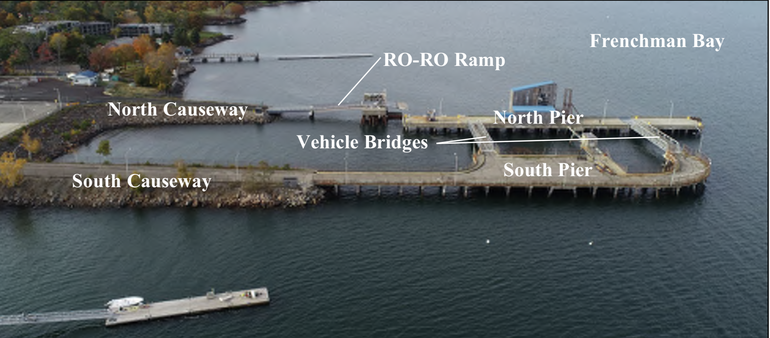
Bar Harbor eyes unused parts of ferry terminal for redevelopment
 Courtesy / GEI Consultants Inc.
The north pier of Bar Harbor’s terminal was redeveloped for the CAT ferry. The town plans to redevelop the rest of the site. "RO-RO" stands for "roll-on roll-off."
Courtesy / GEI Consultants Inc.
The north pier of Bar Harbor’s terminal was redeveloped for the CAT ferry. The town plans to redevelop the rest of the site. "RO-RO" stands for "roll-on roll-off."
When the town of Bar Harbor bought a defunct ferry terminal from the Maine Department of Transportation in 2019, it had a vision to redevelop it as a marina for a variety of stakeholders.
Several years later, it’s still working out how that vision might play out.
“It’s a painfully slow process,” Jeff Miller, chair of the town’s harbor committee, recently told the town council.
An assessment by Portland engineering firm GEI Consultants Inc., completed in 2021, made it clear that the infrastructure is badly deteriorated. Located on the town’s outskirts, the upland side of the property consists of 6.8 acres with 467 feet of shorefront on the bay. Extending into the water is a system of piers, causeways and vehicle and pedestrian bridges that have badly degraded over the past 60 years. The structures are riddled with cracked concrete and holes both above and below the water’s surface. Many pilings have lost their plating and encasements.
The terminal, at 121 Eden St., was built in 1956 to serve as a port for the MV Bluenose, which provided ferry service to Yarmouth, Nova Scotia. The Bluenose was eventually replaced by the CAT ferry, operated by Bay Ferries Ltd. of Charlottetown, Prince Edward Island. The CAT stopped operating in Bar Harbor in 2009.
The town completed its $3.5 million purchase of the site from the state of Maine in 2019 and worked out a lease with Bay Ferries to restart CAT service. Bay Ferries began a rebuild that included a new terminal building and improvements to the site’s north pier. After pandemic delays, the terminal was finally put to use for CAT service in 2022.
In the meantime, the town considered what to do with the remaining property. In 2020, the town council contracted with GEI to assess the condition of the south pier and other infrastructure to determine options for possible reuse.
The harbor committee subsequently recommended that the town demolish infrastructure not needed to fulfill its contract with Bay Ferries and come up with options for phased development of a multi-purpose facility, with potential uses such as a boat ramp for recreational and limited commercial use, traditional marina services, an expansion of the town’s working waterfront, and tendering cruise ship passengers.

The site is viewed as a unique redevelopment opportunity, with public access and revenue-generating options as well as scenic views of the bay.
GEI is now working with the harbor committee to look at design development and repurposing of the south pier and other elements of the terminal, Town Manager Kevin Sutherland told the council.
The goal is to have a design completed by December 2023, he said.
Miller noted the town has conducted a number of public sessions to get input from stakeholders on what the site should be used for.
“We’ve asked, we’ve been told, we’ve got that information,” he said.
The committee has given GEI a list of stakeholders to be contacted for their specific input. The list is extensive, he said, and includes Bar Harbor residents and members of industries such as the fisheries, aquaculture and hospitality. It’s expected that GEI Consultants will provide a summary of stakeholder input in January or February, along with a draft concept plan for demolishing some facilities and building a new boat ramp.
An element that’s already emerged from all stakeholders as a top priority, so far, is the need for a boat ramp that can be used at all tide levels.
“In our opinion, it’s kind of the low-hanging fruit to try to get something going there for the town,” Miller said.
He added, “It would be nice if we could at least get to the point where, within no more than two years, we actually are working on that actual construction phase.”
Redevelopment is expected to be costly, he said.
“Nothing there is going to be inexpensive,” he said. “Even just dismantling what’s there is going to be a chunk of change.”
It’s expected redevelopment will occur through multiple phases over a number of years.
“It’s going to be a long road,” he said.
In the meantime, the town has secured the south pier to block access.
“It is definitely dangerous,” said Miller.
Councilors tossed around the idea of looking into grant programs for the redevelopment. But, noted Council Chair Valerie Peacock, “We don’t have the design yet to figure out how much it costs and how to pay for it.”
Factors of the design, councilors said, might include uses by revenue-generating tenants, uses appropriate for the size of the site, and any environmental concerns there might be in taking down structures. Also to be considered, they said, is how long Bay Ferries will continue to operate at the site and what happens to the upgraded north pier if the company departs.
GEI recently started draft concept plan development and plans to continue the stakeholder and public input outreach process, either before the concept plans are ready for review or after.
According to a GEI memo to the town, plan elements will also focus on resilience to sea level rise and climate change risks, consistent with recommendations of the Maine Climate Council, as well as other considerations such as user needs, seasonal demands, marina uses, vehicular access, pedestrian and vehicular connectivity with downtown and other sites and attractions, and ADA accessibility.
“Consideration for climate change is critical to any long-term planning efforts for coastal development,” the memo said.










0 Comments